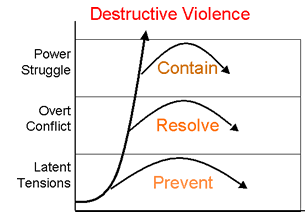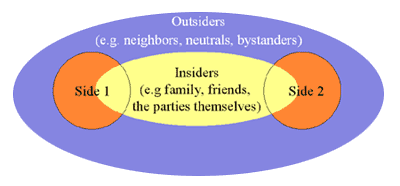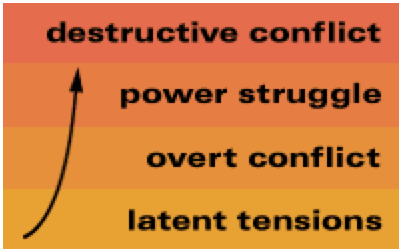Everyday Third Side Actions
The Third Side is us. As simple societies like the Semai have long recognized, it is everyone’s responsibility to prevent harmful conflict. “You have to help resolve a dispute,” one Semai explained. “If you don’t intervene and something happens between the two disputants, you are accountable.” “Friends for life don’t let friends fight” is the slogan of a successful media campaign against violence in Boston. That could be the motto of the Third Side.
We may not think of ourselves as third parties – in fact we generally don’t. Yet each of us has the opportunity to serve as a third party in the conflicts around us – either as outsiders or as insiders. We constitute the family, the friends, the colleagues, the neighbors, the onlookers, the witnesses. Even when no third party is present, each of us has the opportunity to mediate our own disputes by taking the Third Side.
In short, the Third Side is not some mysterious or special other. It is us. The missing alternative to force and domination is in our hands.
Getting to peace is rarely easy, but there are some simple steps any of us can take to begin to mobilize the Third Side:
Change the story. The principal obstacle to preventing destructive conflict lies in our minds – in the fatalistic beliefs that discourage people from even trying. The story that humans have always warred, and always will, is spread unchallenged from person to person and from parent to child. It is time, in our everyday conversations, to question and refute this story and its embedded assumptions about human nature. It is time to give our children – and ourselves – a more accurate and more positive picture of our past and our future prospects. From realistic hope springs action.
Learn some skills. “Why do you feel this way?” said the student recently trained in conflict resolution to the youth pointing a gun at his head at a nighttime basketball game, “Don’t you understand that if anything happens to me, you’ll get life?” The youth put the gun away.
Each of us can benefit from honing our joint problem-solving and conflict resolution skills. There are many ways: take a class, read a book, or get some coaching from a friend or colleague. The key lies in practice; the more, the better. As with sports, no matter how skilled you already are, there always remains room for improvement.
Start close to home. “You have to remember all the steps,” reports third-grade mediator Ian Morton, “but when it’s over, it makes you feel very happy to help a friend.” We don’t need to look far to find a place to practice our Thirdsider skills. Daily occasions abound at home among our family and friends, at school, at work among our colleagues, and in the neighborhood. It may be to listen and hear the parties out. It may be to facilitate dialogue between those who do not understand one another. It may be to use peer pressure to urge constructive resolution. Each of us has a role to play.
Mediate your own disputes. “This one kid came up to me and was pushing me,” recalls fifth-grader Alexandria Ritch, “and I said ‘Don’t push me.’ He said, ‘What are you going to do about it, hit me?’ And I said, ‘I would never hurt you. I’m a mediator, and hitting others isn’t right.’ He started listening to me. . . and then he said he was sorry and we got on the bus. I felt better because I was being a bigger person.”
Even closer to home are our own disputes, which often prove the most challenging. It may not be easy to gain perspective, yet, if we can, each of the ten Thirdsider roles is available to us. We can attempt to build bridges, heal wounds, and resolve our differences by ourselves. In the absence of a mediator, we can, in effect, mediate our own dispute. If our efforts falter, we can actively seek the help of others, mobilizing the Third Side around us.
Do what you do best. As you look around and wonder how you can contribute to the wider community, you don’t need to start from scratch. Instead, begin with what you already do and add an extra third-side dimension. Parents can help their children learn how to deal with conflicts constructively. A teacher can weave a conflict resolution strand into the subject matter, whether it is history, social studies, or languages. A minister can help people apologize and forgive. A lawyer can facilitate the creative resolution of conflicts by practicing “collaborative lawyering” or mediation. A journalist can spotlight emergent conflicts for public attention. A police officer can mediate domestic disputes informally. Some of us may have special talents as Teachers, others as “Mediators, and still others as Peacekeepers. The key is to identify your distinctive competence and incorporate it into what you do every day.
Volunteer your services. “In over two hundred cases [I mediated], I can think of only two that bogged down,” says seventy-four-year-old volunteer community mediator Gail Robertson, speaking of her experience over the past ten years. “If they’re willing to listen, speak, and follow the process, it works.”
Like Gail Robertson, anyone of us can volunteer our time and skills. Many communities have neighborhood justice centers that rely on volunteer Mediators and staff. Schools have peer mediation programs. You can volunteer as a peer juror, a neighborhood peace officer, or as a mentor or sports coach for needy teens. You can also teach others in the community about joint problem-solving and conflict resolution. Further afield, there exist volunteer opportunities as election monitor or humanitarian aid worker in conflicted societies. All these roles help build a strong Third Side.
Fill a missing role. The firm’s strategic planning committee was paralyzed. Although the vice presidents disagreed with the senior vice president for administration, none of them wanted to confront him directly, nor did they intend to implement what he proposed. Finally Olivia Lane spoke up in exasperation, pointing out how they were skirting the real issues. As manager of executive training and development, she was not formally a member of the committee, but informally she had spent a lot of time listening individually to each of the participants. Once she brought the issues out in the open, the committee members began discussing them in earnest. For follow-up sessions, the committee appointed Lane as official facilitator. The result: the first strategic plan ever implemented at the firm.
Just as Olivia Lane spotted the conflicting interests and surfaced them as an informal Mediator, so each of us can identify the causes of escalation around us and then play – or find someone else to play – the appropriate roles that address them. In this way, safety net by safety net, we can construct a comprehensive system for transforming conflict.
Create a winning alliance. “The deal we cut [with the police] was, ‘Take this one off the streets, we can deal with him in prison ministry,'” explained the Reverend Jeffrey Brown. The police, in turn, depend on the ministers to work with the more winnable kids. “Right now,” said the Reverend Eugene Rivers, “any cop in Dorchester can dump a kid off in Baker House [a neighborhood recreation center and parish house run by Rivers] and say, ‘Look, I’m gonna crack this kid’s skull, take him.’ So we have taken the pressure off the police to play heavies.” The ministers and the police have created a winning alliance against teenage violence.
Don’t fall into the trap of thinking you need to do it all yourself. Recruit help. Take a lesson from the Bushmen and speak to all the disputants’ friends and relatives. Keep on strengthening the Third Side until it becomes more powerful than any aggressor.
Urge your organization to take the Third Side. We all belong to organizations – businesses, professional associations, unions, civic clubs, cultural affinity groups, or political parties – that can greatly magnify our Thirdsider efforts. We can leverage our membership, turning our organizations into Thirdsiders. On the issues that divide the wider community, our organizations can take a stand for constructive discussion. They can serve as Bridge-Builders, offering public fora for dialogue, or as Equalizers, providing weaker parties with information and support.
Support the Third Side in the wider community. “As long as we the citizens let [negative political campaigning] be effective, it will continue,” says Becky Cain of the League of Women Voters. “We are the only ones with the power to stop it.” Even where you are unable to assume a direct role in the wider conflicts surrounding us, you can still lend your voice to the Third Side. You can speak out and cast your vote against harmful conflict and violence. When even a single person takes a stand, the ripple effect can result in surprising change.
Help build Thirdsider institutions. Programs and institutions are the backbone of the Third Side. Each of us can champion the teaching of conflict resolution and tolerance to children of all ages as a standard part of the school curriculum. We can promote the establishment of community mediation centers. In the wider world, we can support the development of international mediation services, the strengthening of the International Criminal Court, and the creation of standing peacekeeping units that can act promptly to prevent genocide and war.
Help create a social movement. For some, serving as part of the Third Side may mean nothing more than putting a new label on what they have been doing all the time. For others, it may mean engaging in new activities. For all, it may mean a new awareness of themselves as part of the larger human community engaged in the historic project of learning to live and work together. Just as the environmental movement addresses the relationship between human beings and nature, so a coexistence movement would deal with the relationship between human beings and other humans. In coalition with other great social movements like those for human rights, women’s rights, and democracy, such a movement could help raise awareness and mobilize a powerful Third Side.
Such a movement needs a new vocabulary. Imagine a prefix like “co” (from the Latin “with”) starting to be attached to names in the way that “eco” is for environmental terms. “Co-democracy” would mean the practice of democracy through consensus-building and collaboration rather than by destructive combat. “Co-history” would mean the history of how humans have gotten along together. “Co-culture” would mean a culture of conflict resolution and cooperation.
Disseminate and share. Use the following tools to inform people who may be involved in a conflict:
- Wallet cards: These wallet cards are easy to carry and are a simple way share and remember the basic perspective of the Third Side. Each pdf has a two-page 2×5 standard business card layout. You can print these pages on both sides of the cards to create your own thirdside wallet cards. Download the “What is the Third Side” wallet cards.
- Three Questions for Thirdsiders: Download the “Three Questions for Thirdsiders” wallet card.
- Handout: This one-page handout describes the Third Side. Download the “What is the Third Side?” One Pager.
- Sticker Designs: Some sample sticker designs for creating your own thirdside stickers. You can share the stickers with your community and post them around your town. Download the Third Side Sticker Designs.
We know that the Third Side can work because it already does – some of the time. In Kenneth Boulding’s words, “what exists is possible.” The task remaining is to take the success stories and make them the norm. Plenty of obstacles remain but none are insurmountable. There is in fact no good reason why we cannot get to peace.




